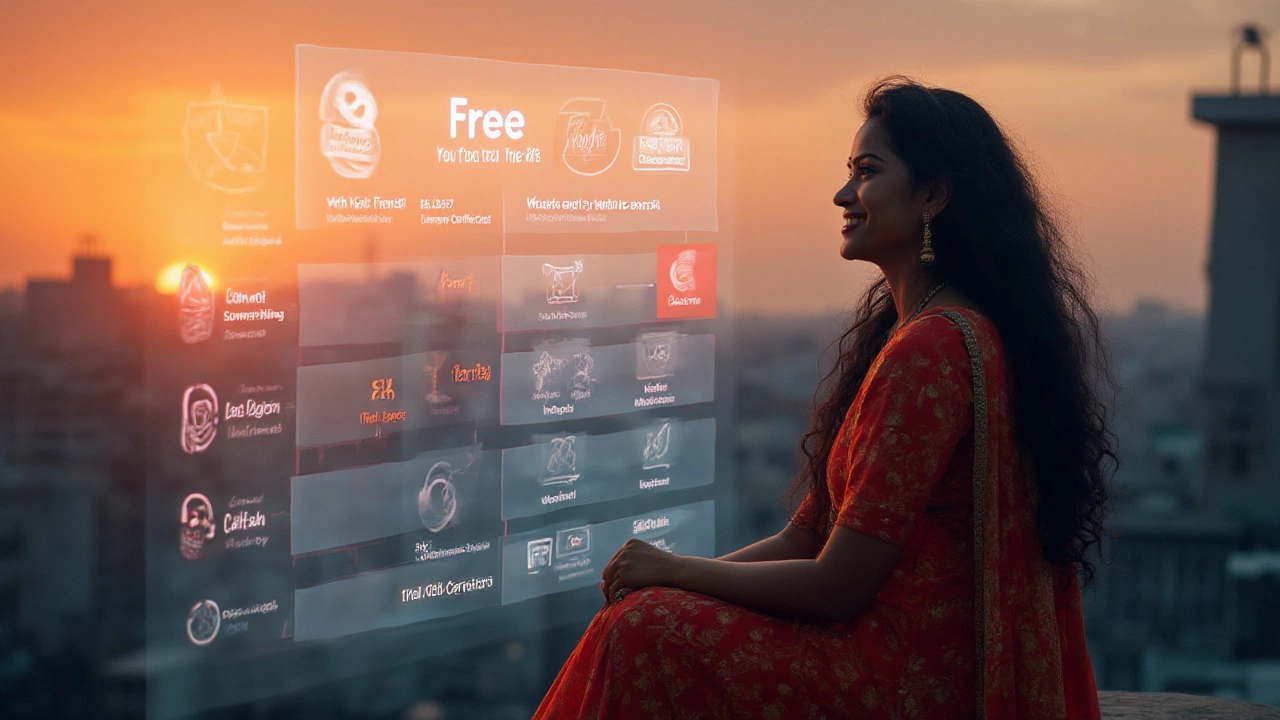Stop for a second and imagine being able to learn from a Stanford professor about artificial intelligence, brush up on your English grammar with a Cambridge-trained teacher, or pick up coding skills for free—all while waiting for your laundry to finish. Sounds unreal, right? In 2025, studying from some of the world’s best minds can really cost nothing more than the price of your internet connection. But here's the catch: online learning platforms are everywhere, and they all promise to be the best. So which one actually lives up to the hype when your wallet is staying in your pocket? Let’s get into the facts, useful tips, and a bit of what most people miss about free learning online.
The Rise of Free Online Learning: Why Now?
Back in the early 2000s, people mostly heard about online learning only for super-specialized stuff—think IT certifications or distance MBAs. That shifted fast. Fast-forward to 2025 and the landscape looks nothing like it did just a decade ago. The Covid-19 pandemic turbo-charged online learning, making it not just a fallback, but the go-to way to learn for millions. In London, it’s now common for job ads to list “self-guided online course” experience as a plus. In 2023, the Online Learning Index showed over 900 million people enrolled in online courses globally. But what drove this tidal wave? Easy access, flexibility, and—yes—cost. With universities opening up their content, and companies realising the value of upskilling workers, free became sustainable thanks to paid certifications, donations, or government incentives.
Now, it’s not just about adult night classes, either. Teens prepping for GCSEs, career changers moving into tech, or grandparents curious about ancient history—they’re all clicking ‘Play’ on something. Harvard’s free computer science course saw over 3.5 million enrollees in 2024 alone. The UN reported that for populations in rural or underprivileged regions, access to free courses often means one of the only available options for further study.
Let’s get practical though. Not every “free” platform actually feels free. Some ask you to pay for certificates, others bung you with constant adverts, and some have almost no truly free content once you scroll past the homepage. That’s where it becomes crucial to know which sites mean business and which just want your clicks. As the field gets crowded, knowing how to separate the genuinely valuable from the time-wasters is almost a skill in itself.
The Top Free Learning Platforms: What Sets Them Apart?
You’ll see the same four or five names pop up in most rankings: Coursera, edX, Khan Academy, FutureLearn, and Udemy. But what does “best” actually mean in this context? Is it quality of teaching, variety, ease of use, or something else? Here’s the nitty-gritty break down.
- Coursera: Often seen as the gold standard. Courses from the world’s top universities (like Yale and Imperial College London). A huge range of topics, and most are “audit free,” meaning you can see the videos, readings and basic quizzes without paying. Certification? That does cost, but you can do the entire learning bit without opening your wallet.
- edX: Very similar to Coursera. Loads of university partners, including MIT and Harvard. They also have a generous “audit” policy, and rich discussion forums. Interesting fact: edX went non-profit in its early years but now operates for-profit, still keeping core courses free.
- Khan Academy: The undisputed hero for school students. Free to use, completely ad-free, and covers everything from primary maths to advanced chemistry. Khan Academy’s adaptive exercises are famous for building real understanding.
- FutureLearn: Based in the UK. Fantastic for arts, humanities, culture, politics. Think “BBC documentary, but interactive.” You can study for free, and only pay if you want a digital certificate or longer access.
- Udemy: Not everything is free here, but a huge chunk of crash courses (think Excel basics, Python for beginners, photography intros) come at zero cost. Their open platform model means teachers set their prices, so you’ll need to hunt for the free gems.
For language learning, Duolingo deserves its own hat-tip. Totally free, bite-sized, fun, and supports dozens of languages. Self-taught maths fans should check Brilliant.org, which offers problem-solving courses—though much of their advanced content is paywalled.
Some platforms get niche but are unbeatable in that area. Codeacademy’s free tier gives you serious hands-on coding, while Alison shines for workplace skills—think time management, health and safety, or digital marketing. You don’t get a wall-full of certificates, but you do get practical skills employers in London (and everywhere else) are looking for.

Learning for Free: The Hidden Costs (and Real Perks)
No one likes surprises—unless it’s more content than you expected. But “free” online learning comes with quirks and catches. For starters, you’ll almost never get a formal qualification for free. That’s the bit platforms charge for. But here’s where it gets interesting: in a recent survey, 64% of recruiters said they care more about seeing “initiative to self-learn” than whether the certificate is from a paid version.
Sometimes, the “audit mode” skips graded assignments, or forums might not be fully active for non-payers. And you might see a “limited access” timer—FutureLearn, for example, might free up the course for 4-6 weeks only. After that, you’ll need to pay if you want ongoing access or a certificate.
But don’t get discouraged—because here’s the advantage: no upfront costs mean low risk. Didn’t gel with the teaching style? No stress, just try something else. Missed a deadline? Just enroll again. These platforms now serve up personalized recommendations based on your interest, and let you build learning playlists (Coursera and Khan Academy do this particularly well).
The real perks? Exposure to expert-level knowledge from places like Stanford, Oxford, or Google, completely free. Flexible scheduling matters too. Lots of people—me included—fit learning into the weirdest parts of the day: waiting for a train, lunch-breaks, winding down before bed. There are even success stories of people switching entire careers after binge-learning for a few months (coding bootcamps love to share these).
Accessibility is better than ever. If reading isn’t your thing, platforms offer video lectures, audio-only modes, and interactive exercises. Khan Academy even has adaptive problem sets that get harder as you improve. EdX and Coursera subtitles cater to learners worldwide, opening up specialised courses to non-native speakers.
Choosing the Right Free Platform: Personal Fit Matters
It’s easy to get overwhelmed by choice and end up never starting—like the Netflix of education, right? The best free online learning platform for you will depend on your goals, not generic rankings. Here’s a quick table comparing the essentials for five platforms that most Londoners (and honestly, people everywhere) keep coming back to:
| Platform | Strength | Certificate Cost | Main Subjects | Availability |
|---|---|---|---|---|
| Coursera | Top university lectures | £40-£65 per | STEM, Business, Humanities | 24/7 (app & web) |
| edX | Wide university offering | £35-£150 per | STEM, Arts, Medicine | 24/7 (app & web) |
| Khan Academy | Best for basics, school | £0 | Maths, Science, SAT/GCSE prep | 24/7 (app & web) |
| FutureLearn | UK culture & society, global issues | £39-£59 per | Social Science, Languages, Law | 24/7 (web) |
| Udemy | Huge topic range, skills focus | Varies, some free | IT, Business, Arts, Life Skills | 24/7 (app & web) |
If you want to earn a degree or a career-boosting certificate, these platforms will still charge—and honesty, that's how they keep the lights on. If you just want to learn, audit modes are your friend. Titles like "Machine Learning" from Stanford (on Coursera) or "The Science of Happiness" (edX) are free to join and full of clever insights.
My spouse, Camilla, tested language learning platforms last spring while prepping for a trip to Spain. She loved Duolingo for basics, but when she wanted to dive deeper into grammar and real-world skills, it was Coursera’s “Spanish for Beginners” (universidad nacional autónoma de México) that helped her chat confidently in Barcelona’s markets. So if you crave peer support or real-world practice, check community ratings, discussion forums, and bonus features before you commit serious time.

Tips for Getting the Most From a Free Online Course
Even the best course won’t help if you just watch videos and never practice. Set realistic weekly targets and consider using a simple old diary or phone reminders. For most people, finishing a “free” course is tougher than paying—because life gets busy. Block out time each week. If you get stuck, jump into the forums or discussion threads. There’s usually someone who’s run into the same problem. Coursera especially has active user forums, and FutureLearn is celebrated for friendly peer discussions.
Mix it up! Don’t obsess about just one platform. Take a maths class on Khan Academy for the basics, then jump to edX for advanced topics. Many people make their own custom ‘curriculums’: YouTube lectures for theory, coding on Codecademy, and quizzes on Brilliant. Variety keeps motivation up.
Finally, use the certificate question as a filter. If you’re learning for a job search, see if employers value badges from a particular platform. For self-growth or fun, skip the pressure. And don’t neglect reviews; check course ratings and feedback before starting. PC Magazine and Class Central run yearly real-user reviews that spotlight winners and duds. Pro tip: If a free course sucks, ditch it and find a better-rated one—no guilt, no wasted money.
So which is the best online learning platform for free? It depends—on your goals, your style, and your need for a certificate. But the best part? There are more great options every year, and the only real limit is your curiosity.





Write a comment